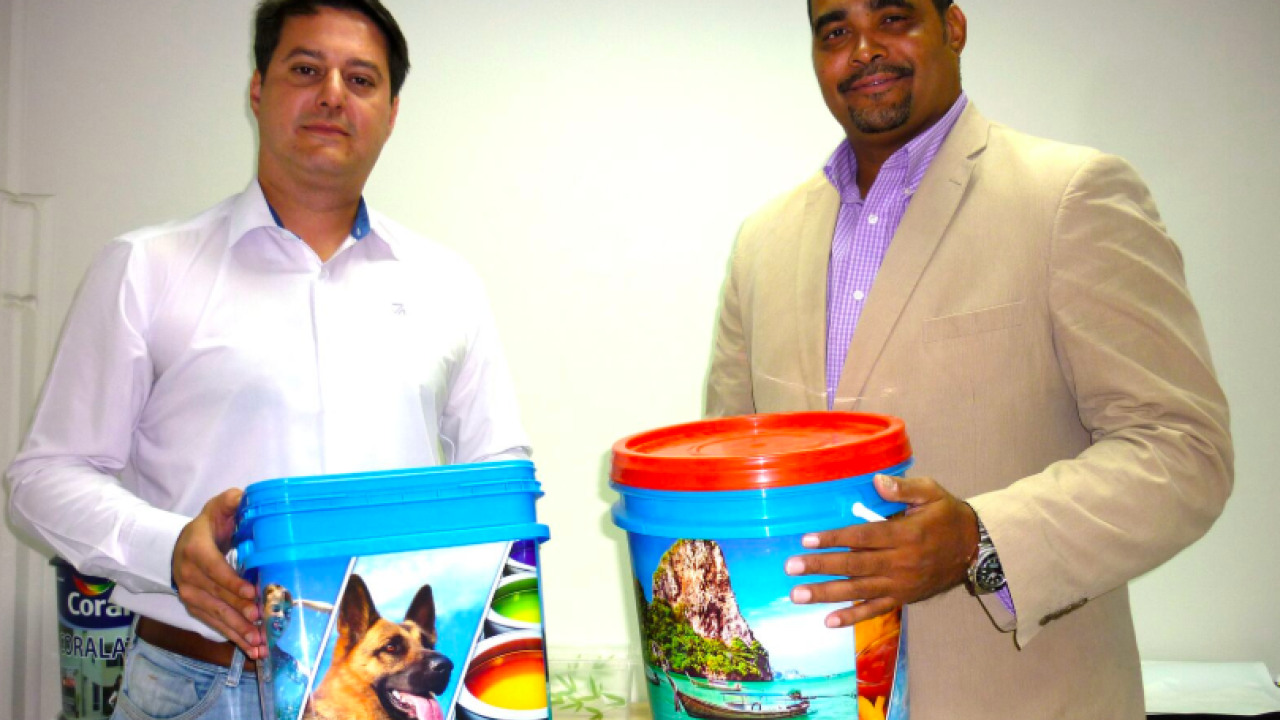In-mold success for Gráfica Rami in Brazil

Gráfica Rami was founded in 1978 by José Carlos Rizzieri, still CEO today, as a commercial printing house producing magazines, publicity materials and labels. It installed its first KBA offset press – the first of its kind in Brazil – in 1991, and by 1996 was focusing exclusively on label printing. ‘There was increasing local demand for our labels, particularly in the beverage market for beer, wine, and liquors,’ says R&D director Fernando Rizzieri, one of three second-generation Rizzieris to work at the company.
Today Gráfica Rami runs five KBA presses, all equipped with varnish and of 5, 6 or 8 colors. The presses can print on paper or film, using conventional, oxidative and/or UV inks and water-based or UV varnishes.
‘We have always had a philosophy of pioneering new technology,’ says José Carlos Rizzieri. ‘As well as the first KBA offset press in Brazil, we installed the first Polar and Busch cutters and first Artwork Systems [now Esko] security screening software in the country. We were also a pioneer in offset-printed metallized papers for the beer market.’
Gráfica Rami’s latest investments add to the breakthrough installations. As part of a $10 million USD investment program last year, it installed the first KBA finishing system in the Americas and its fifth KBA press, an 8-color machine with reel-to-sheet infeed which is the first dedicated KBA label press in Brazil. ‘The press has been customized to handle very fine synthetic and plastic materials,’ says Fernando Rizzieri. ‘It has excellent control and quality, and high productivity at 18,000 sheets an hour. KBA told us that there is no other project like this in the world.’
As well as the KBA press and finishing system, the investment program also covered pre-press in the form of an Amsky offset platemaking system. The company has had an in-house pre-press department since 2002. Thanks to these investments, according to Fernando Rizzieri, capacity will be increased by 120 percent. The company was previously producing 1,800 tons of labels per annum, a figure expected to rise to some 4,000 tons.
As well as equipment, Gráfica Rami has invested in its factory too: its 4,500sqm facility in Jundiaí in Sao Paulo state, which houses 150 staff, was increased by 2,000sqm after the company bought adjacent premises.
The investment in additional capacity leaves Gráfica Rami well placed to take advantage both of the improving economic situation in Brazil, and the increasing market share of in-mold labels, which has evolved into the company’s core business since it began production in 1997.
‘2015 was not a good year in the Brazilian economy; there was lower demand,’ recalls Fernando Rizzieri. ‘But in 2016 we achieved 40 percent growth – a great result – and 2017 growth was 20 percent.’
In-mold growth
Gráfica Rami began printing in-mold and blow-mold labels in 1997, with Yupo supplying its synthetic materials. Initially, in-mold labels represented 30 percent of production, with 70 percent taken by sheet-fed offset printed labels. Today, those figures have reversed, with in-mold – at 70 percent – now the company’s core business. Its main end user segments for in-mold labels are food, beverage, cleaning products and industrial paints.
‘We began by researching the market, and Yupo technicians from Japan visited our factory to talk to us and carry out tests,’ says Fernando Rizzieri. ‘Yupo is a pioneer in materials for blow-mold labels. One of the big advantages is the stability of their material on the press. In 19 years using Yupo’s materials, we have never had to send back any materials and never had any cause for complaint.’
‘The consistent quality in each batch of materials is also fundamental,’ adds José Carlos Rizzieri. Today, Yupo supplies 30 percent of Gráfica Rami’s in-mold materials, with Treofan and Innovia also providers. The converter has formulated some 30 different recipes for in-mold label production, covering a multitude of end user requirements.
Equipment for in-mold label production was bought locally, but materials have been imported since day one. ‘We don’t buy from distributors. We talk directly to the manufacturers to help ensure the product is developed according to our needs,’ says Fernando Rizzieri. ‘Technical service from Yupo is excellent. We speak directly with their technicians.’
Globally, in-mold is estimated to represent 3 percent of the overall label market. In Brazil, Fernando Rizzieri estimates that it is growing by 15-20 percent a year. ‘This isn’t to do with overall market growth, but because in-mold is gaining market share from other label formats. It is particularly strong in industrial paints and margarines, for example. It creates a high quality appearance for the product, and the in-mold label strengthens the package meaning that less resin can be used in thin-wall products.
‘We have a 30 percent share of the Brazilian in-mold market. Imported labels make up 40 percent, while 30 percent comes from other local suppliers. We believe we are the number one in-mold label printer in Latin America. It requires a big investment and is a complex process technically. Many companies have tried to enter the market but without success.’
Gráfica Rami has found success convincing local brands to make the switch to in-mold labels for their products. ‘It is easier to persuade a local brand than a multinational, as they are more agile,’ explains Fernando Rizzieri. ‘But the move by smaller brands spurs the bigger brands into action. We have seen this happen in both the toy and chemical markets, for example.’
He cites the example of a local food brand. ‘Initially they weren’t convinced by the extra cost of in-mold labels. We delivered them a batch of free samples. They rang us two days later to order more, saying that all the products decorated with our in-mold labels had been sold straight away.’
Stay up to date
Subscribe to the free Label News newsletter and receive the latest content every week. We'll never share your email address.


